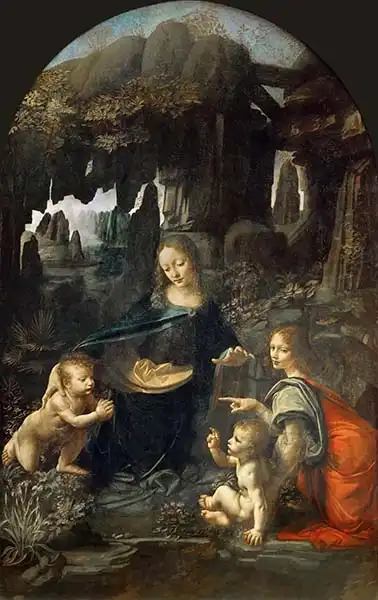About this finishing
Print. The image is printed on the top quality 10-ink HP Z9PS printer on HP matte 270 g / m2 paper. You can choose any size to an accuracy of 1 cm. A margin of 5 cm around the image is added to the size of the motif.


You can find a detailed description about our finishings
here.
Madonna of the Rocks
Date:
1478Medium:
oil on panel transferred to canvasLocation:
Louvre, Paris, FranceDimensions:
199 x 122Overall,
Leonardo da Vinci's "Madonna of the Rocks" is one of his most famous and beautiful works, known for its compositional excellence, masterful detailing, and exquisite depiction of light and shadow.
The main motif is the Madonna sitting on the rocks in the
landscape where the cave is located and holding the baby
Jesus on her lap. Saint John the Baptist kneels beside the Child Jesus and points to him, while an angel stands behind the Madonna holding a bunch of flowers.
The painting is known for its fine and realistic quality. Leonardo's ability to capture light, texture and detail is remarkable. The landscape in the background is beautifully rendered, with prominent rocks, trees and water features. It creates an impression of mystery and beauty.
The Madonna in the painting has a soothing expression on her face and holds the Baby Jesus with tenderness. The painting creates an intimate and peaceful atmosphere that emphasizes the religious and human connection between the Madonna and the Child Jesus.
Vinci painted picture Madonna of the Rocks in 1478. Prevailing color of this fine art print is green and its shape is portrait. Original size is 199 x 122. This art piece is located in Louvre, Paris, France. This image is printed on demand - you can choose material, size and finishing.
Leonardo da Vinci (1452-1519). He was an important Italian
Renaissance painter, sculptor, architect, musician, mathematician and inventor. He is even considered the greatest humanist of all time. His works are special and innovative thanks to the search of compositional balance, the movement of characters and perspectives achieved by the play of light and colour. He used a distinctive colour blending technique known as sfumato. His attempt to capture the character, mood and expression of people was also significant. Among his most famous works are
The Last Supper, Lady with an Ermine, Self Portrait and of course
Mona Lisa, which is one of the most famous works of art in the history of painting.


